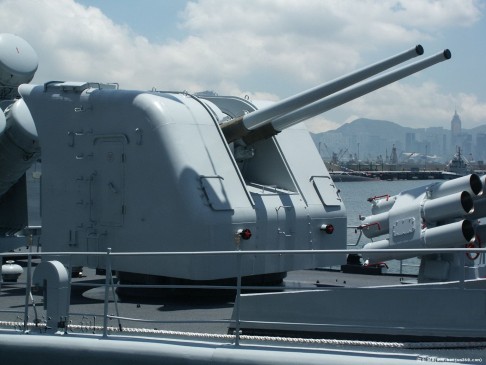
- Intent: To make a standard laser cannon for Ne-Cal vessels - with a twist
- Image Source: China Insider - bottom picture
- Canon Link: N/A
- Restricted Missions: N/A
- Primary Source: China Insider
- Manufacturer: Ne-Cal Military Engineering
- Model: NL-07-class laser cannon
- Affiliation: Ne-Cal made vessels only
- Modularity: NL-07 laser cannons can be made automatic or have their targeting systems altered.
- Production: Limited
- Material: Titanium barrels, durasteel frame
- Classification: Laser cannon
- Size: Average
- Weight: Average
- Ammunition Type: Power cell
- Ammunition Capacity: Potentially unlimited (Takes energy from the core of a capital ship)
- Reload Speed: Fast (When both barrels are fired, the reload time takes two seconds.)
- Effective Range: Average (~1 km maximum range)
- Rate of Fire: High (32 projectiles per minute)
- Stopping Power: Varies (Against shielding, a Low rating would be suitable. However, in inflicting damage to hulls, the damage rating would be High. Explained below.)
- Recoil: None
Damage modifiers
Capital ship shielding - 80% effectiveness
Hull + solid armor - 140% effectiveness
Organic matter - 100% effectiveness
Asteroids + natural materials - 100% effectiveness
Automatic mode
No crew required, NL-07 automatically locks on and fires at the largest hostile warship in its range. To avoid friendly fire, the targeting computer can be set to attack certain shapes or materials found in enemy vessels. The targeting system can be reversed so the NL-07 cannon prioritizes the smallest warships. Recommended for skeleton crews or replacing fallen gunners.
Manual mode
Two crew members man a targeting station just below the turret. A navigator looks at a targeting radar connected to the laser cannon and points out enemies. A gunner controls when and where the laser cannon fires at, as well as which barrels are firing. Recommended for larger, more devoted crews, especially trained gun operators. Often performs better than the automatic mode of the NL-07, especially in the middle of a battlefield.
Strengths:
- Body Breaker - Due to increased effectiveness against exposed hull, gunfire from multiple Null laser cannons can be devastating to unshielded vessels.
- Relentless Fire - A Null laser cannon's two barrels can spit a round almost every second on average. While that would be about the same rate of fire, if not lower, than that of an average pistol, it is a significantly larger and more energy-consuming weapon.
- Unending Assault - Due to the fact that Null laser cannons are designed for use on capital ships, their ammunition is unlimited as long as its host ship's core remains intact.
- Glass Cannon - NL-07 cannons are lightly armored, with multiple well-placed shots from a starfighter being able to destroy it.
- High Explosive - While Null laser cannons can deal large amounts of damage to unshielded vessels, shielded warships are an entirely different story. With a 20% damage reduction, shielded cruisers and Destroyers can be an extremely difficult nut for NL-07 laser cannons to crack.
- Picky Home - Only Ne-Cal vessels can equip NL-07 cannons unless the host vessel's wiring is specially modified to gain similarities with typical Ne-Cal warships.
Ne-Cal engineers had often used foreign turrets for their vessels, but as the company expanded, it began to be able to produce its own weapons systems, saving credits. The first of these was the Flyswatter light AA gun, but soon, Ne-Cal engineers sought more. Work on a laser cannon model began, and basic goals of the project were set. The cannon would be a twin-barreled, have a high fire rate, and be on a rotating turret.
The first prototype had two functioning barrels and a rotating turret, but its fire rate was only 16 projectiles/minute, a rate seen as too low. The second prototype increased the rate of fire up to 27 projectiles/minute, but experienced common turret malfunctions and was scrapped. The third prototype, while reducing the fire rate to 25 projectiles/minute, fixed all turret rotation problems. The fourth prototype, using all the experience of the previous prototypes, had a fire rate of 32 projectiles/minute and had no turret malfunctions.
After this was figured out, the project administration came up with an idea to make their laser cannon stick out from those of competitors. While it would cost a debuff in other aspects, a buff against certain targets was created to encourage unique usage. After a heated discussion, it was decided that this buff would be against exposed hull. The sacrificed damage would be against the shielding of capital ships. Scientists in the laser cannon project managed to perfect such damage modifiers, but the next step was getting them in the cannon.
The fifth prototype failed to show any damage modifiers, and the sixth experienced a total malfunction twenty seconds into the testing session. Finally, the seventh prototype worked. It proved to have superior damage over hulls and solid, shielded metals, at the cost of a slightly less damage output against shields. Organic matter and asteroids were damaged normally, since they were not part of the damage modifying plan.
Near the beginning of production, it was realized that the laser cannon prototypes could only connect with Ne-Cal wiring. However, Ne-Cal administration was still very satisfied with their results and explained that mass-production would begin to strain Ne-Cal's budget. Dubbed the NL-07, these laser cannons began to be equipped on Ne-Cal capital ships, ready to prove their worth.








